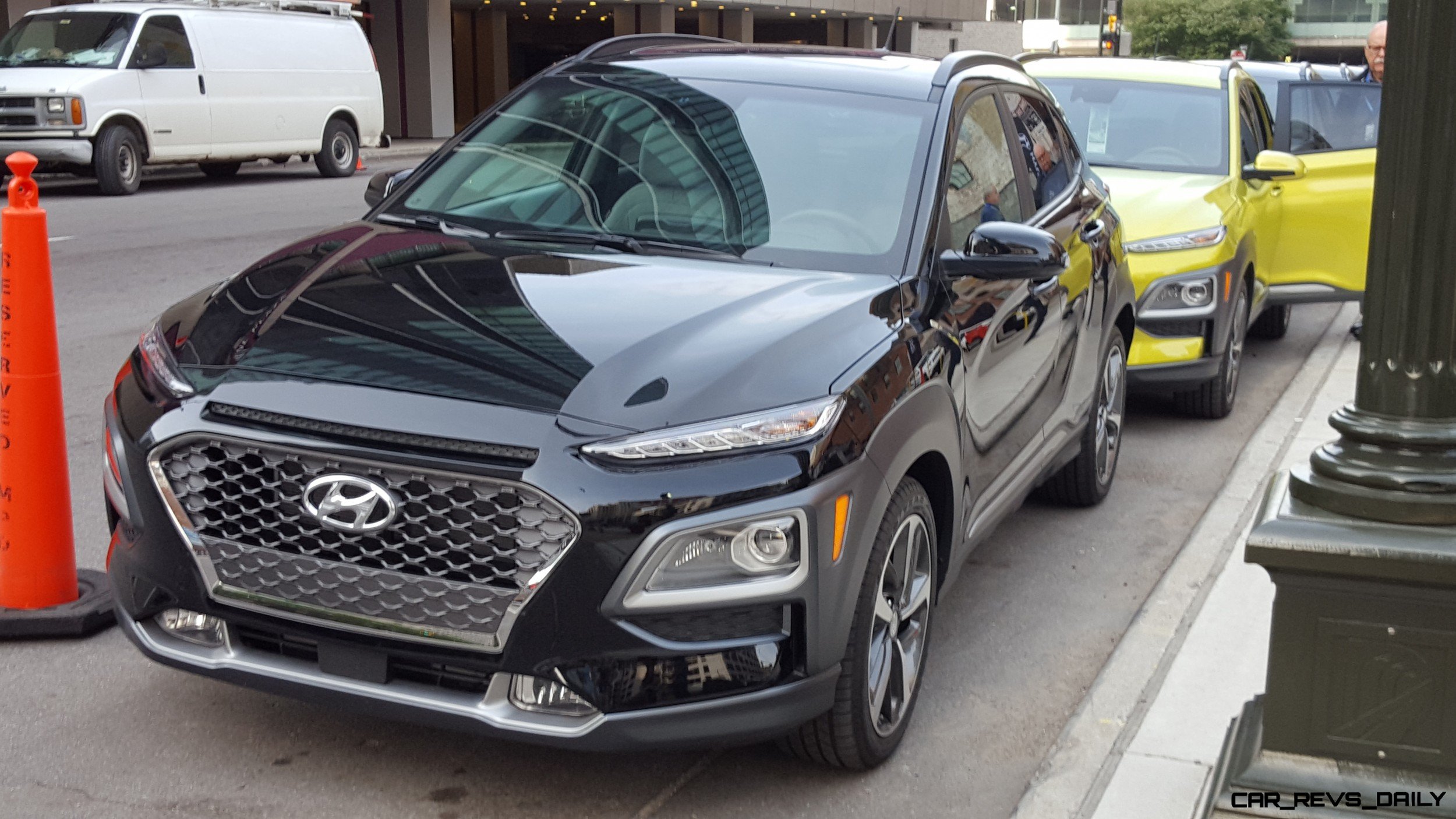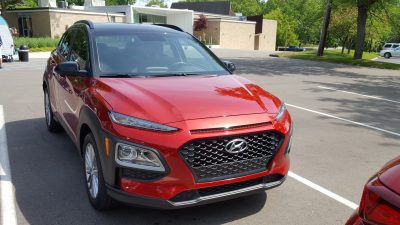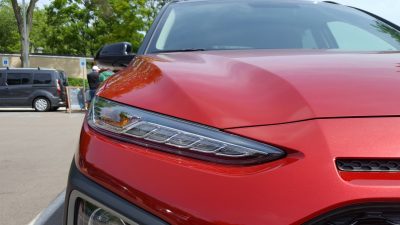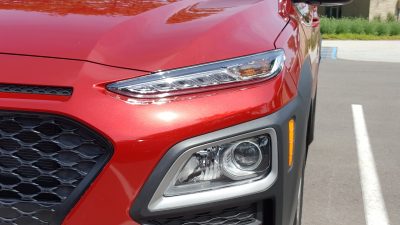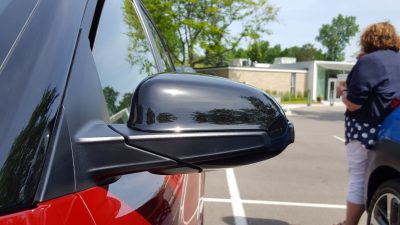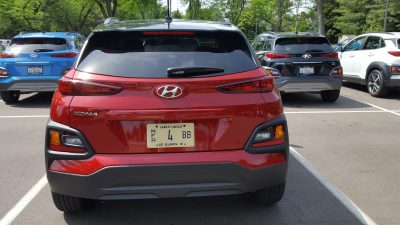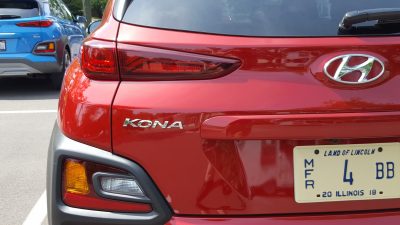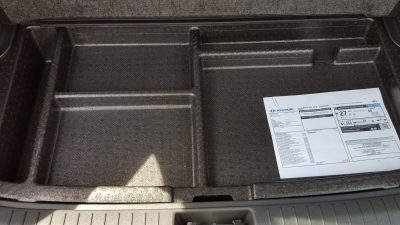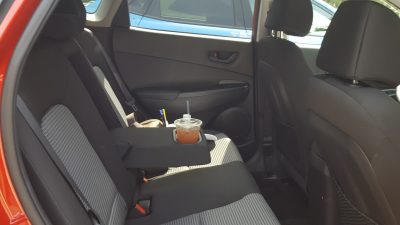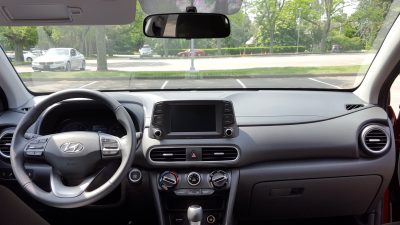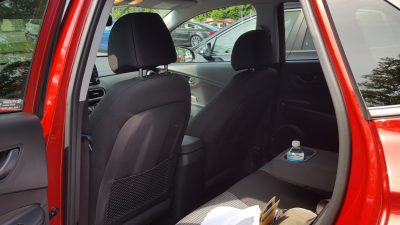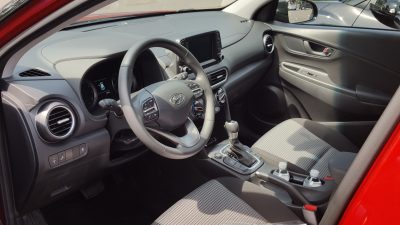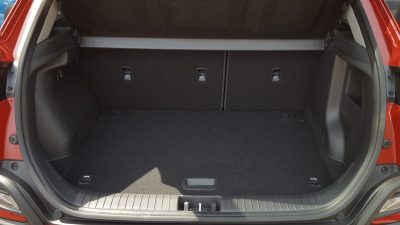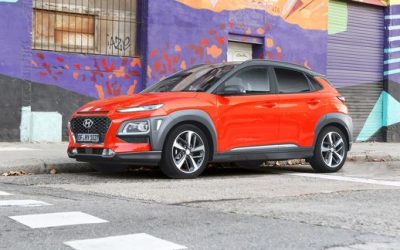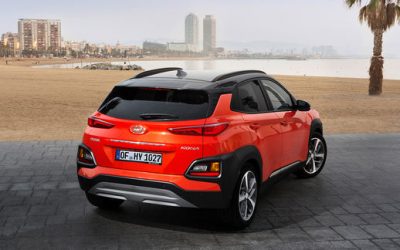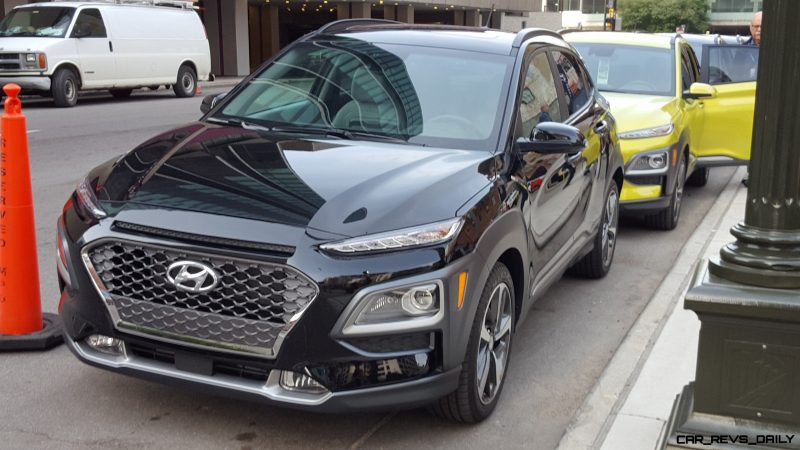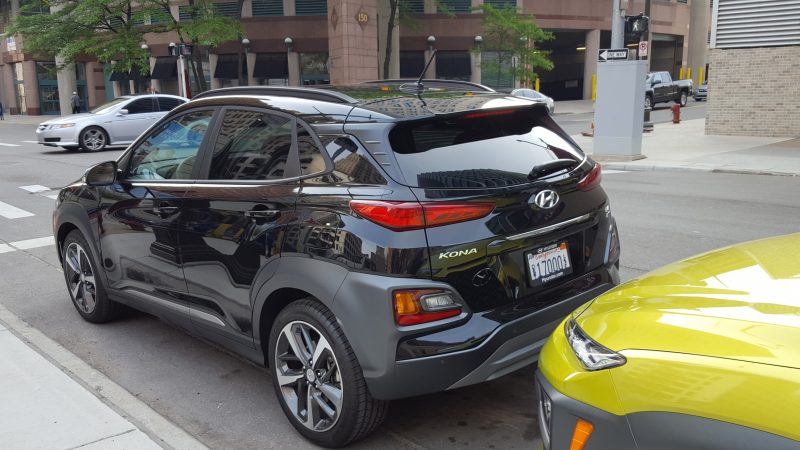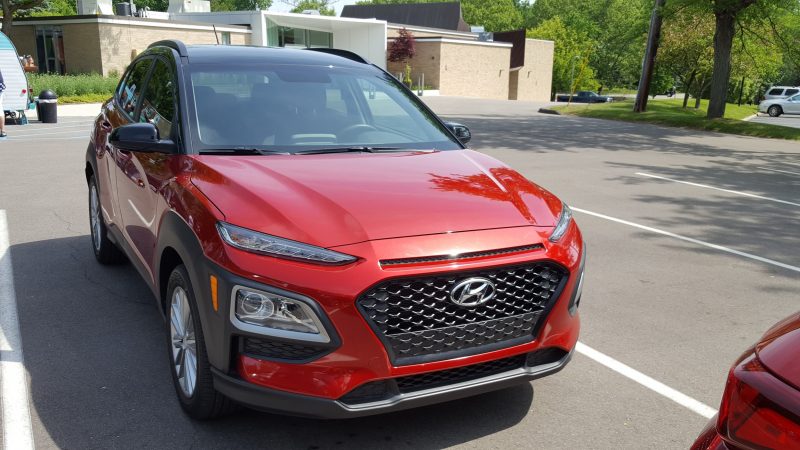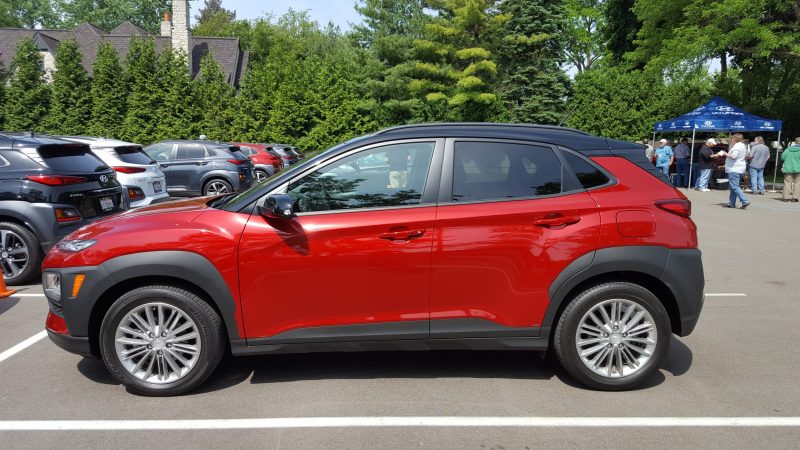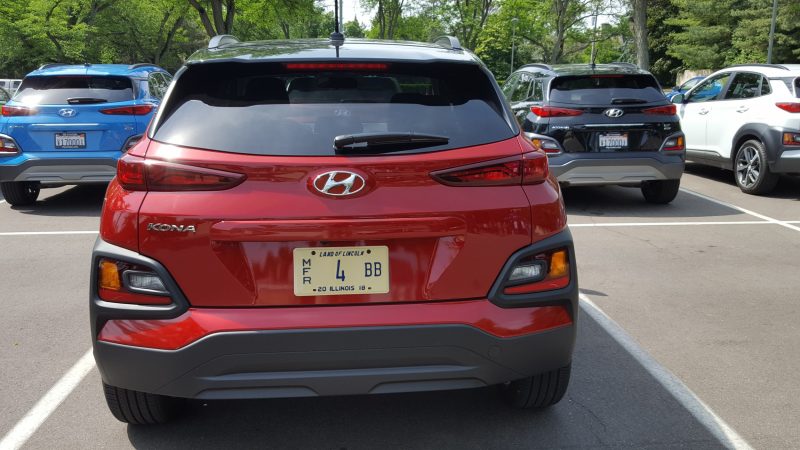Typically when it comes to small value focused cars, Hyundai has always been one of the front runners, and has largely done a good job catering to this still strong segment with offerings like the Elantra GT, the recently tested Hyundai Veloster, as well as the budget minded Hyundai Accent.
However, in a curious twist of irony, the firm did not have a formal compact crossover entry to take advantage of this recently growing offshoot of the utility market.
The 2018 Hyundai Kona aims to rectify that, but can the Kona’s youthful confidence allow it to standout in a segment dominated by benchmarks? Or does it emerge as a detriment.
Admittedly some folks may not be sold at first glance by its funky exterior styling. Hyundai claims that the styling language dubbed “Urban Smart Armor” shares some of its inspiration with select design elements including those found on the BAC Mono track car.
While we ponder how the automotive equivalent of a pear and an orange could ever get together, the Kona’s styling is still fresh and expressive, especially once you get a chance to know this tiny CUV better.
The front fascia like many entries in this segment features LED daytime running lights as well as above bumper mounted headlights. Both are mounted within a piece of strategically placed plastic trim, which is designed to help provide protection from common mishaps including incidents in parking lots.
The rear fascia incorporates a similar theme with the turn signals and rear backup lights mounted at bumper height, while the taillights are nestled just below the liftgate glass. The cladding does enhance the crossover vibe, but the end result is still a very busy canvas that can look either beautiful, or outright bewildering depending on the viewing angle.
Our favorite element though is the front grille design. Hyundai claims that it is supposed to mimic the way molten steel flows out of vats at the company’s steel factory, and it manages to create a distinctively elegant appearance, which works quite well on the Kona, as well as other current Hyundai offerings. When compared with rivals, the Kona does have more substance than the Honda HR-V, Nissan Kicks, and the Ford Ecosport . In addition, the design also holds it own against other popular entries like the rugged Jeep Renegade and the slick Buick Encore.
Sadly, traits from the “Urban Smart Armor” design will not funnel their way into other Hyundai compacts which is a shame since we are actually fans of the bulk of the cues here, especially the aggressively honed rear tail lights as well as the side profile which has a distinctly sporty yet functional appearance. Imagine a next generation Accent or Elantra with ‘Urban Smart Armor” traits (it would look really cool.)
Meanwhile, the interior of the Kona is a pleasant place to spend time in. In typical compact crossover fashion, there are some hard plastics that are scattered about, but Hyundai designers did a good job of only using them in appropriate places where consumers will not necessarily notice them at first glance. Ergonomics here are first rate, with many buttons and switches in easy reach of occupants.
With the cheap plastics being relegated to unseen background filler, the materials that are within easy view are high quality and many of them feel good to the touch.
The front seats offer good amounts of leg room, and considering that the Kona is one of the smallest entries in the segment, we we’re genuinely impressed with the amounts of head and shoulder room that were present. However, the Kona’s short length is noticed in the back, with passengers having to suffer from tight legroom. While the 34.6 inches of room present is suitable for a young family, other buyers looking to haul average sized adults might have to look elsewhere.
Thankfully, the Kona makes up some ground by offering a class leading 19.2 cubic feet of cargo space with the rear seats in place. Fold them down, and you are rewarded with an ample 45.8 cubic feet of space to swallow bigger loads. Smaller items can be stored in a smaller storage area below the cargo floor to help keep them out of view from prying eyes.
Hyundai is clearly betting on the Kona standing out from segment benchmarks thanks to its extensive suite of equipment, and indeed this spunky CUV does offer alot for the money. This includes a standard 7.0 inch infotainment system with Apple CarPlay and Android Auto capability, wireless phone charging, as well as a comprehensive heads up display system.
Many of its rivals either don’t offer these features at all, or only offer one or two of these items.
PERFORMANCE
Performance for the 2018 Kona comes from two different four cylinder offerings, which allows it to fall roughly in line with what is seen in other compact crossover offerings. With the Kona projecting a strong islander vibe, it’s a pity that the base 2.0 liter engine takes kicking its proverbial feet up and relaxing a bit too seriously. Good for a rather paltry 147 horsepower, the 2.0 liter sees duty in SE and SEL models, and while its 33 mpg freeway rating is very impressive, performance on the other hand is too relaxed for our tastes.
When the engine is pushed hard, it produces alot of noise, but very little acceleration to backup the auditory blitzkrieg that permeates the cabin especially at freeway speeds. A six speed automatic is the sole transmission here, and it did a good job delivering smooth shifts which made up for the engine’s lazy performance somewhat.
We highly recommend the optional 1.6 liter turbocharged four cylinder which resides in Limited and Ultimate grade Konas. This engine proved to be much zestier than the sleepy 2.0 liter, and its 175 horsepower was highly appreciated, especially on Metro Detroit’s freeway network. Acceleration proved to be this engine’s strong suit, and like a highly trained volleyball player, it did a good job showcasing its responsiveness, especially in the middle part of the rev band, which allowed the engine to undertake passing maneuvers with less fuss than the base engine.
Predictably, there is some early turbo lag when accelerating (a trait shared with other Hyundai/Kia offering with this engine,) but once the turbo has a chance to fully spool up, it turns into a compelling beast with plenty of power to spare.
The 7-speed dual-clutch automatic delivers quick and timely shifts, and this helps transform the Kona into a relatively fun runabout, though we will stop short of calling it a formal performance model (take notes N-brand engineers.)
A key feature on higher grade Konas with all-wheel drive is the torque-vectoring system which uses the brakes to help modulate braking to each wheel. This helps sharpen the turning circle, and in turn allows the Kona to boast sharp reflexes, especially in twistier sections of tarmac. Unfortunately, it appears that Hyundai engineers did not pay as much attention to overall ride quality.
When subjected to some of the pothole ridden roads that dot the Metro Detroit area, the jolts and ruts did cause the Kona to be tossed about somewhat. Cabin noise is higher in the Kona than many cars, but then again, the bulk of compact crossover offerings are not exactly known for having whisper quiet interiors anyway, so we are willing to give the Kona a pass here in this regard.
PRICING
Pricing for the 2018 Kona starts at $19,000 for the base Kona SE which nets you standard LED daytime running lights, Bluetooth, as well as the fore-mentioned 7-inch infotainment system. SEL trim starts at a slightly higher $20,650, but adding the $1,500 Tech Package brings lane Keep Assist, a power sunroof, and even forward collision alert to budget minded buyers. Look for these two models to target base versions of the Honda HR-V, Jeep Renegade, as well as the Nissan Kicks thanks to their inclusion of equipment that all three simply do not have.
However, it is the $24,200 Limited model that really allows the Kona to flex its muscle when it comes to equipment. In addition to being the lowest trim that can be equipped with the 1.6 liter turbo, Limited models also double down on convenience features, with goodies such as leather seats, standard sunroof, lane change assist technology, and push button start. We expect this trim to be the volume seller for the Kona lineup, and it should allow the tiny Hyundai to bring the fight to higher grade Ford EcoSport models, as well as near luxury offerings like the Buick Encore.
Finally the range topping $26,900 Ultimate model rounds out the equipment enhancements with its bigger 8.0 inch infotainment system, wireless phone charging capability, as well as its heads up display system. The Ultimate’s price can get expensive when it is fully equipped, but there’s no denying the long term value that permeates the entire Kona lineup. Our biggest gripe with its pricing ladder is the lack of flexibility For example, it would be neat if the 1.6 liter could appear as optional equipment on the SEL instead of buyers being forced into the higher trims to obtain it (it’s that good.)
Overall the 2018 Hyundai Kona appears to have what it takes to flip the compact CUV segment upside down. Look past its funky styling, and the Kona’s finer details make themselves quiet apparent to consumers. And like a fine tropical drink, it’s sometimes the finer details that are the most important to ensure maximum enjoyment.

Carl Malek has been an automotive journalist for over 10 years. First starting out as a freelance photographer before making the transition to writing during college, his work has appeared on numerous automotive forums as well as websites such as Autoshopper.com.
Carl is also a big fan of British vehicles with the bulk of his devotion going to the Morgan Motor Company as well as offerings from Lotus, MG, and Caterham. When he is not writing about automobiles, Carl enjoys spending time with his family and friends in the Metro Detroit area, as well as spending time with his adorable pets.

